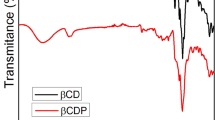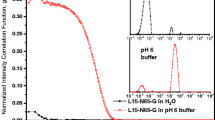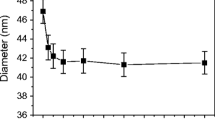Abstract
Copolymers of (D,L-lactide-random-ε-caprolactone)-block-poly(ethylene glycol)-block-(D,L-lactide-random-ε-caprolactone) (PLECs) were synthesized with varied D,L-lactide (LA) content and different molecular weights (20 and 50 kDa). Polymer ratios, particularly the content of LA, had significant effect on the release of trypan blue. A lower trypan blue release rate was observed from monolithic rods composed of PLECs with higher CL/LA ratio. High LA content in polymer rod led to increase of the hydrophilicity of the polymer rod and the decrease of CL content resulted in the increase of the hydrophilicity of PLECs and hydrolysis rate. Spin-coating technique was employed to coat PCL-b-PEG-b-PCL membrane on PLEC rod with controlled thickness. Results showed that membrane encased rods can produce different release pattern including delayed release, zero-ordered release and burst release depending on the types of inner rod and membrane. Results for this study indicated that PLEC rods could provide the zero-order release profile of highly water-soluble molecules. Moreover, the longer lag phase was observed at higher thickness. These results suggest that these polymer rods were potential drug delivery systems that can provide controlled drug release profiles.






Similar content being viewed by others
References
Gliadel wafers for treatment of brain tumors (1998) Med Lett Drugs Ther 40(1035):92
Qian F, Nasongkla N, Gao J (2002) Membrane-encased polymer millirods for sustained release of 5-fluorouracil. J Biomed Mater Res 61(2):203–211
Qian F, Szymanski A, Gao J (2001) Fabrication and characterization of controlled release poly(D, L-lactide-co-glycolide) millirods. J Biomed Mater Res 55(4):512–522
Weinberg BD, Ai H, Blanco E, Anderson JM, Gao J (2007) Antitumor efficacy and local distribution of doxorubicin via intratumoral delivery from polymer millirods. J Biomed Mater Res Part A 81A(1):161–170
Khamlao W, Hongeng S, Sakdapipanich J, Nasongkla N (2012) Preparation of self-solidifying polymeric depots from PLEC-PEG-PLEC triblock copolymers as an injectable drug delivery system. J Polym Res 19(3):1–12
Manaspon C, Hongeng S, Boongird A, Nasongkla N (2012) Preparation and in vitro characterization of SN-38-Loaded, self-forming polymeric depots as an injectable drug delivery system. J Pharm Sci 101(10):3708–3717
Boongird A, Nasongkla N, Hongeng S, Sukdawong N, Sa-Nguanruang W, Larbcharoensub N (2011) Biocompatibility study of glycofurol in rat brains. Exp Biol Med (Maywood, NJ) 236(1):77–83
Baker RW (1987) In: Controlled release of biologically active agents. Wiley, New York
Nasongkla N, Bey E, Ren J, Ai H, Khemtong C, Guthi JS, Chin S-F, Sherry AD, Boothman DA, Gao J (2006) Multifunctional polymeric micelles as cancer-targeted, MRI-ultrasensitive drug delivery systems. Nano Lett 6(11):2427–2430
Wang Z, Wang S, Guidoin R, Marois Y, Zhang Z (2006) In vitro homogeneous and heterogeneous degradation of poly(ϵ-caprolactone/polyethylene glycol/L-lactide): the absence of autocatalysis and the role of enzymes. J Biomed Mater Res Part A 79A(1):6–15
Ge H, Hu Y, Jiang X, Cheng D, Yuan Y, Bi H, Yang C (2002) Preparation, characterization, and drug release behaviors of drug nimodipine-loaded poly(ε-caprolactone)-poly(ethylene oxide)-poly(ε-caprolactone) amphiphilic triblock copolymer micelles. J Pharm Sci 91(6):1463–1473
Shogren R (1997) Water vapor permeability of biodegradable polymers. J Polym Environ 5(2):91–95
Pearce EM, Schaefgen JR (1977) Contemporary topics in polymer science, vol 2. Plenum, New York
Meidong L, Jianzhong B, Shenguo W (1999) Synthesis and characterization of polycaprolactone/poly(ethylene oxide)/polylactide tri-component copolymers. J Biomater Sci Polym Ed 10(4):501–512
Nasongkla N, Boongird A, Hongeng S, Manaspon C, Larbcharoensub N (2012) Preparation and biocompatibility study of in situ forming polymer implants in rat brains. J Mater Sci Mater Med 23(2):497–505. doi:10.1007/s10856-011-4520-3
Hu Y, Jiang X, Ding Y, Zhang L, Yang C, Zhang J, Chen J, Yang Y (2003) Preparation and drug release behaviors of nimodipine-loaded poly(caprolactone)–poly(ethylene oxide)–polylactide amphiphilic copolymer nanoparticles. Biomaterials 24(13):2395–2404
Huang M-H, Li S, Vert M (2004) Synthesis and degradation of PLA–PCL–PLA triblock copolymer prepared by successive polymerization of ε-caprolactone and dl-lactide. Polymer 45(26):8675–8681. doi:10.1016/j.polymer.2004.10.054
Dash S, Murthy PN, Nath L, Chowdhury P (2010) Kinetic modeling on drug release from controlled drug delivery systems. Acta Poloniae Pharm—Drug Res 67(3):217–223
Korsmeyer RW, Gurny R, Doelker E, Buri P, Peppas NA (1983) Mechanisms of solute release from porous hydrophilic polymers. Int J Pharm 15(1):25–35
Rich J, Jaakkola T, Tirri T, Närhi T, Yli-Urpo A, Seppälä J (2002) In vitro evaluation of poly(epsilon-caprolactone-co-DL-lactide)/bioactive glass composites. Biomaterials 23(10):2143–2150
Zhang L, Hu Y, Jiang X, Yang C, Lu W, Yang YH (2004) Camptothecin derivative-loaded poly(caprolactone-co-lactide)-b-PEG-b-poly(caprolactone-co-lactide) nanoparticles and their biodistribution in mice. J Control Release 96(1):135–148
Zhang Y, Wang C, Yang W, Shi B, Fu S (2005) Tri-component diblock copolymers of poly(ethylene glycol)–poly(ε-caprolactone-co -lactide): synthesis, characterization and loading camptothecin. Colloid Polym Sci 283(11):1246–1252
Mallapragada SK, Peppas NA, Colombo P (1997) Crystal dissolution-controlled release systems. II. Metronidazole release from semicrystalline poly(vinyl alcohol) systems. J Biomed Mater Res 36(1):125–130
Miyajima M, Koshika A, Ji O, Ikeda M, Nishimura K (1997) Effect of polymer crystallinity on papaverine release from poly (l-lactic acid) matrix. J Control Release 49(2–3):207–215
Bramfeldt H, Sarazin P, Vermette P (2007) Characterization, degradation, and mechanical strength of poly(D, L-lactide-co-ϵ-caprolactone)-poly(ethylene glycol)-poly(D, L-lactide-co-ϵ-caprolactone). J Biomed Mater Res Part A 83A(2):503–511
Li S (1999) Hydrolytic degradation characteristics of aliphatic polyesters derived from lactic and glycolic acids. J Biomed Mater Res 48(3):342–353
Murakami H, Kobayashi M, Takeuchi H, Kawashima Y (2000) Utilization of poly(dl-lactide-co-glycolide) nanoparticles for preparation of mini-depot tablets by direct compression. J Control Release 67(1):29–36
Valle L, Camps R, Díaz A, Franco L, Rodríguez-Galán A, Puiggalí J (2011) Electrospinning of polylactide and polycaprolactone mixtures for preparation of materials with tunable drug release properties. J Polym Res 18(6):1903–1917
Babazadeh M, Edjlali L, Rashidian L (2007) Application of 2-hydroxyethyl methacrylate polymers in controlled release of 5-aminosalicylic acid as a colon-specific drug. J Polym Res 14(3):207–213
Jonnalagadda S, Robinson DH (2000) A bioresorbable, polylactide reservoir for diffusional and osmotically controlled drug delivery. AAPS PharmSciTech 1(4):26–34
Tunón Å, Börjesson E, Frenning G, Alderborn G (2003) Drug release from reservoir pellets compacted with some excipients of different physical properties. Eur J Pharm Sci 20(4–5):469–479
Cai K, Yao K, Lin S, Yang Z, Li X, Xie H, Qing T, Gao L (2002) Poly(D, L-lactic acid) surfaces modified by silk fibroin: effects on the culture of osteoblast in vitro. Biomaterials 23(4):1153–1160
Tiaw KS, Goh SW, Hong M, Wang Z, Lan B, Teoh SH (2005) Laser surface modification of poly(ε-caprolactone) (PCL) membrane for tissue engineering applications. Biomaterials 26(7):763–769
Sharp JS, Forrest JA, Jones RAL (2001) Swelling of Poly(dl-lactide) and Polylactide-co-glycolide in humid environments. Macromolecules 34(25):8752–8760
Bei J, Wang W, Wang Z, Wang S (1996) Surface properties and drug release behavior of polycaprolactone polyether blend and copolymer. Polym Adv Technol 7(2):104–107
Sutton D, Wang S, Nasongkla N, Gao J, Dormidontova EE (2007) Doxorubicin and β-Lapachone release and interaction with micellar core materials: experiment and modeling. Exp Biol Med 232(8):1090–1099
Rothen-Weinhold A, Besseghir K, Gurny R (1997) Analysis of the influence of polymer characteristics and core loading on the in vivo release of a somatostatin analogue. Eur J Pharm Sci 5(6):303–313
Acknowledgments
This work was supported by Thailand Research Fund (TRF) and Commission of Higher Education (CHE) for Norased Nasongkla. Financial support for Tararat Chanlen from the Center of Excellence for Innovation in Chemistry (PERCH-CIC), Office of the Higher Education Commission, Ministry of Education is gratefully acknowledged. We are thankful to Pat Akarajirathun for technical help.
Author information
Authors and Affiliations
Corresponding author
Rights and permissions
About this article
Cite this article
Chanlen, T., Hongeng, S. & Nasongkla, N. Tri-component copolymer rods as an implantable reservoir drug delivery system for constant and controllable drug release rate. J Polym Res 19, 36 (2012). https://doi.org/10.1007/s10965-012-0036-x
Received:
Accepted:
Published:
DOI: https://doi.org/10.1007/s10965-012-0036-x




